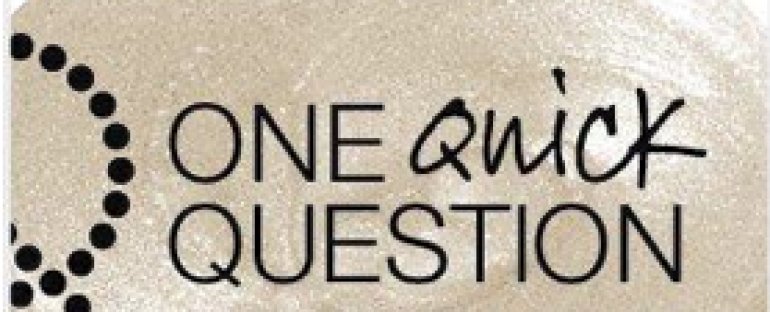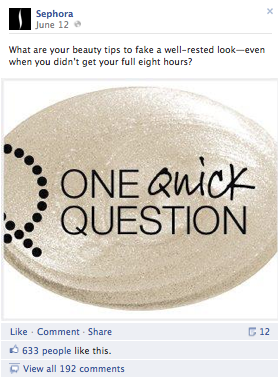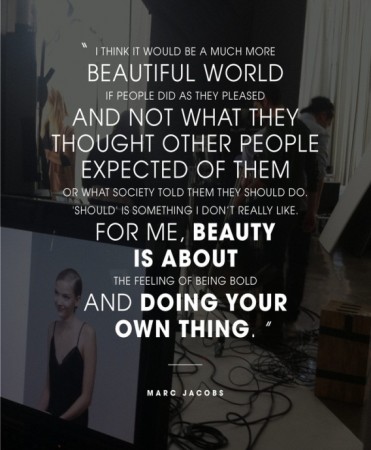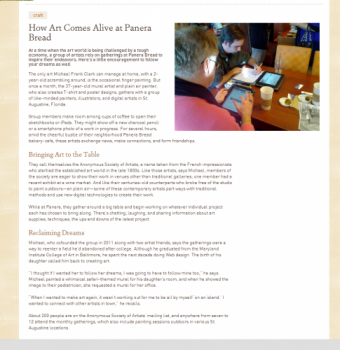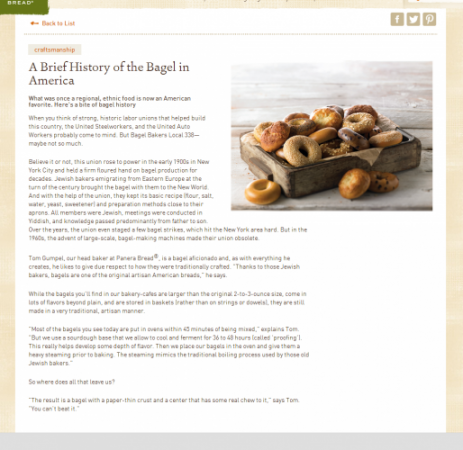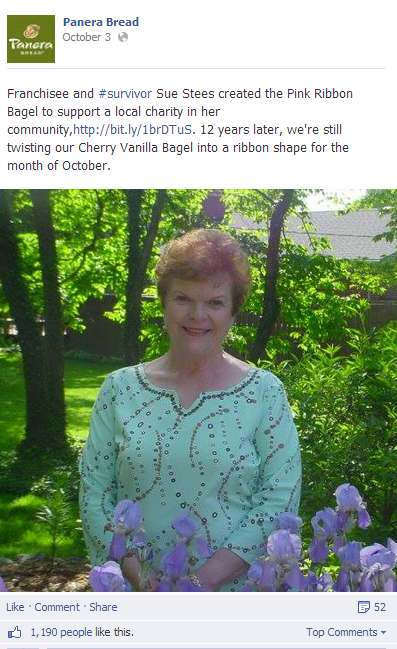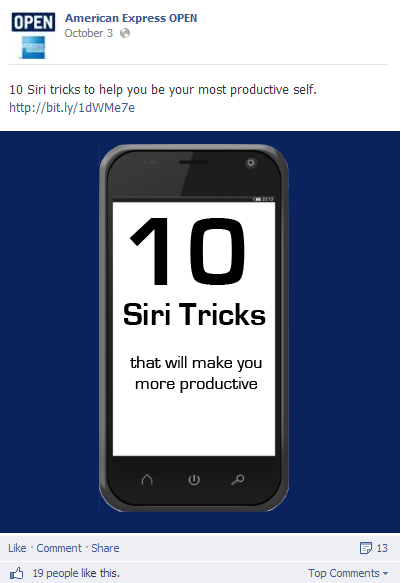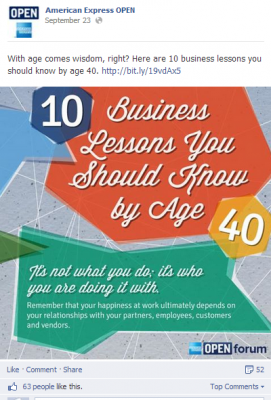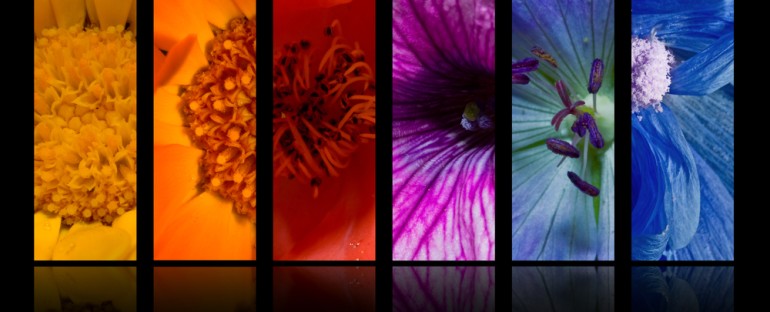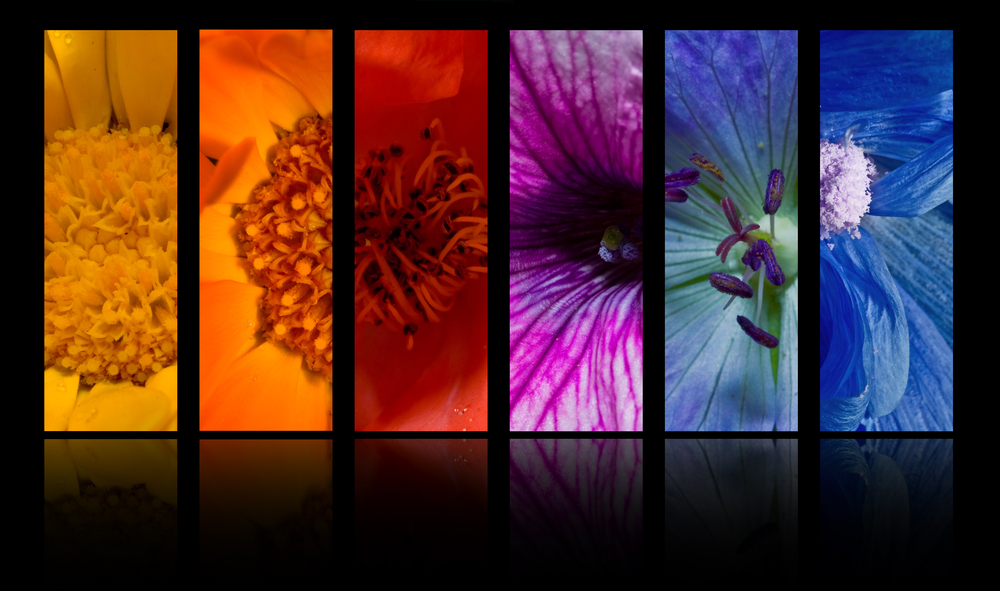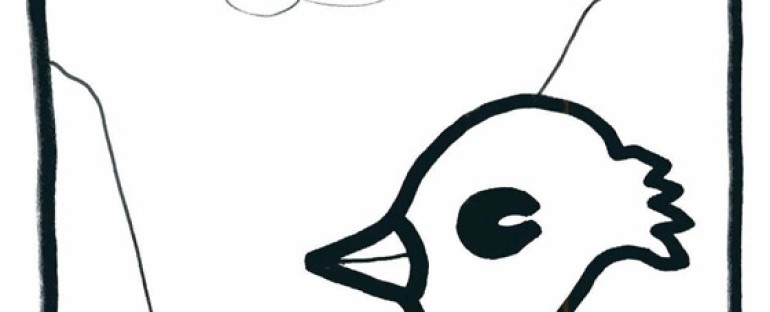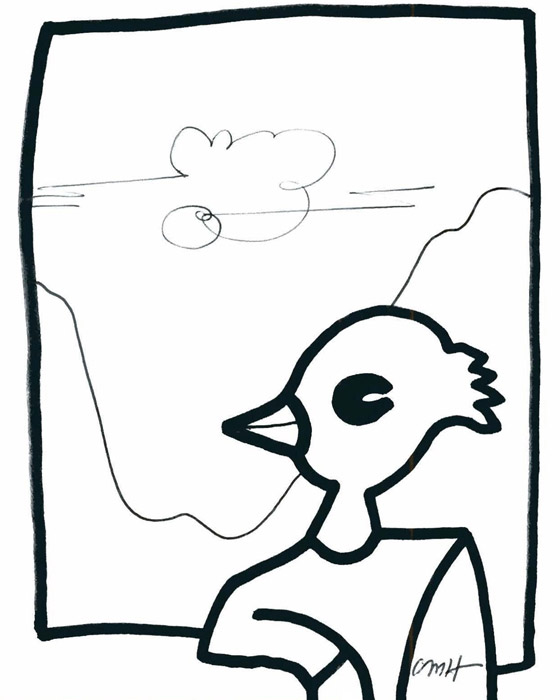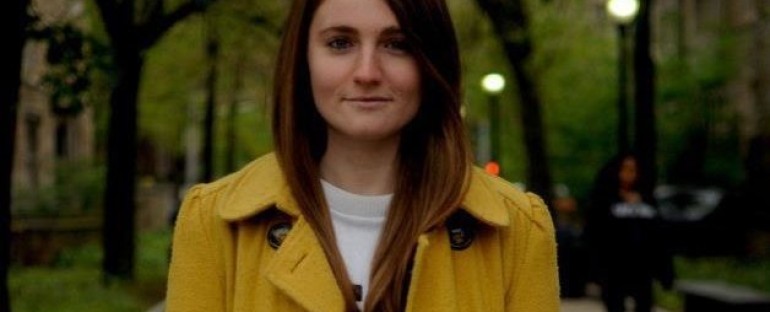There are some that would have you believe that today’s world in which everyone’s a content producer pushing out 140-character tweets, Instagram selfies and instant Vine videos is responsible for creating an industry characterized by mediocrity and lacking in imagination. But that couldn’t be further than the truth.
In fact, those of us in the content and marketing spaces are not less creative; we’re just working to be more creative at a faster pace.
“We’re in a content marketing arms race,” explained Scott Smith, VP, Content Marketing, Cramer-Kasselt, during a recent Social Media Week Chicago presentation. “It’s not about trying to reach everyone at the most efficient cost. It’s not about impressions, or page views. It’s about quality over quantity and having real conversations with individuals.”
To do that requires that brands tap into their unique culture to do more than just tell a story; they must tell their story in a way that connects with their audiences.
The whole point behind creating content, especially in social media channels, is to connect with people. Thanks to reams of data, brands can effectively talk to individuals. To do that effectively requires that brands understand the reader comes first when developing content.
Before launching any kind of content marketing program, brands need to answer some key questions:
- Who is our audience and who isn’t?
- What do we want readers to do?
- What do readers want from us? Can we provide it?
- What assets do we have—people, places, things?
- How do they talk about us when they think we’re not listening Are we listening?
- What do we have to offer that no one else does?
Armed with this critical information, brands will be better prepared to create really great content that accomplishes three basic goals:
- Builds trust with users through usefulness
- Drives measurable consumer action
- Satisfies a brand’s business needs
Too often brands get hung up on having to create really intellectual content based on research or data. That’s important content to have but it doesn’t always have to be so cerebral. Sometimes it just needs to be entertaining and memorable.
There’s really no excuse for brands not to be able to engage readers with quality content as they have so many sources of content at their disposal. Some common sources of content to consider include:
- How We Got Our Start
Share the story of your brand’s history and the milestones it hit along the way.
- Ideas that Didn’t Make the Cut
New product or service ideas that were nixed can be interesting fodder for brand stories.
- The “Why” behind Business Decisions
Consumers can gain real insights into a brand by learning about the drivers behind key business decisions.
- Key Challenges and How We Overcame Them
Honesty and authenticity are critical to creating engaging brand content. Consumers appreciate hearing about challenges facing a brand and, more importantly, how they worked to overcome them.
- Our Culture and Mission
Stories that exemplify your culture and mission can go a long way in humanizing your brand.
- New Product Uses
Think out-of-the-box and offer consumers ideas for new uses for your products. - Your Causes
Stories about the causes your brand is committed to help to define what you stand for.
- Requests for Feedback
Don’t forget to engage consumers by asking for their feedback, questions or comments about your brand. Follow up with content that responds to that feedback or provides updates.
Creating compelling, quality content is not only helps keep brand engaged with their audiences, but it’s also good news for search engines. Nick Papagiannis, VP, Search Director, Cramer-Kasselt stressed that “Content should be beneficial to your customer, reflective of the brand, and optimized for Google.”
Content that is truly search friendly is optimized for the technology environment, includes the right keywords in the right places and is adequately promoted. Links to new content via social channels is one way to effectively rank higher in the search engines while engaging your audiences.
However, even Matt Cutts, head of Google’s Webspam team, has cautioned, “Never sacrifice the quality of your copy for the sake of search engines.” The reader always comes first.
There are a number of brands today that are maximizing the benefits of a great content strategy. Sephora, for example, has been successful in creating engaging video and Tumblr content. It’s clear Sephora’s strategy is to create memorable, shareable content rather than focus on direct lead generation. The brand has a long-term perspective rather than seeking an immediate return. The strategy is working well for Sephora which boasted a 400% increase in iPad traffic to the brand’s website in 2012 and a 300% increase in shipments via mobile in 2012.
Panera Bread is another brand that generates a variety of content which focuses on creating human connections with its customers. The brand’s website includes a number of “feel good” stories about the role Panera Bread plays in local communities. The popular restaurant chain also highlights the history of its products in an engaging way.
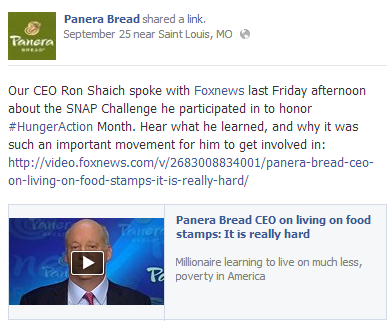
For AMEX Open, a website dedicated to small business networking, content is all about usefulness and creating one-on-one conversations with customers. Backed by 200 expert contributors, the brand’s strategy focuses on delivering content that small business professionals need, providing a forum for them to exchange advice and helping them to make smart decisions.
Are you truly focused on telling YOUR story, or just pushing out content in the hopes of garnering another like or share? Before you hit that publish button, make sure what you’re sharing is advancing your brand story in a personal way that truly connects with your audiences.
In kindergarten, I really, really loved Show and Tell. I would dig deep into my toy box, scrounging through every toy and prized possession I owned as I agonized about selecting the absolute coolest one to share with my classmates. Surrounded by my captive audience, all sitting cross legged in a circle as they intently looked up at me, I was excited to just not proudly hold up my cherished possession but to share with them the story behind it. That was, no doubt, my very first experience with curation.
In my high school and college years, I graduated to creating mixed tapes and CDs for friends and loved ones. I spent an inordinate amount of time carefully selecting each song assembling each playlist to match a theme. There was one for post-break ups, dance parties, girl anthems, new romances and favorite classics. I learned to hone my curation skills as I carefully packaged my playlists to fit specific recipients, moods and themes.
These early experiences helped prepare me for the more advanced curation skill sets I would come to depend on in my chosen career as writer, editor and content strategist.
Today, curation has become not just the latest buzzword but important business. It used to be that if you called yourself a curator, you spent your days in the musty back rooms and marble halls of museums. But today, thanks to technology, a variety of creators, content professionals and consumers are laying claim to the title.
What exactly is curation? As defined by Macmillan Dictionary, curation is “the process of analyzing and sorting content and presenting it in a meaningful and organized way around a specific theme.”
Often sold as the answer to information overload, content curation involves the human act of sifting, sorting, arranging and publishing content around a topic into a story narrative that adds value and helps the audience make sense of the big picture. A content curator, akin to the editor’s role, is to add context to the material for the intended audience. It requires a critical hand to thoughtfully sort a few pieces of content from a wide variety of options.
What content curation is NOT, however, is mere aggregation or regurgitation of content, especially that which is volume- or brand-driven. Content curation is really about storytelling through the selection of choices the curator makes.
When distilled to its simplest form, as a content curator, the content I select is that which I’ve seen, read, or heard about that is something I think my audience should also experience. As a result, the job of content curator is highly personal and individualistic. When you decide to include this content and not that, you are making decisions that best serve the story.
However, curators must walk a fine line between making decisions based on their personal choices with those of the broader audience they serve. The truly talented curators actually convince their audience that they are crafting their own choices rather than adopting someone else’s.
As the role of content curator continues to evolve, brands and professionals alike are redefining it. Red Bull now curates events with street artists. Restaurant guide Zagat curates its listings while Etsy, the ecommerce website focused on handmade or vintage items, uses “guest curators.” Actress Blake Lively recently announced she’s launching a lifestyle company that helps people “curate” their lives. In a Business Insider article, Lively explained, “”The main element of it is that it’s about storytelling and it’s about living a very one-of-a-kind, curated life, and how to achieve that.”
From playful Pinterest collages to carefully nurtured iTune playlists to Amazon’s “list” feature, just about everyone is becoming a curator. There’s even a “Curate Meme” Tumblr page which offers up a series of images with curation jokes.
12 Top Content Curation Sites
There are lots of great content curation sites from which to choose. Here are a dozen of my current favorites.
- BuzzfeedFrom “21 Types of People You See at Disneyland” to “19 Ways iOS 7 is Causing the Actual Apocalypse”, this website is a veritable creation and curation machine thanks to a team of editors and curators who constantly feed their audience with interesting factoids.
- CMO.comAlthough still a lightweight in the curation department, this site targeting Chief Marketing Officers does a good job of packaging content around specific themes.
- Fab.comA true success story, FAB is clearly a content company. After a company reset a year or so ago, it now is on track to reach $100M in revenue. With a continuous stream of colorful, engaging images, the site provides continuous content on everything from furniture, art and jewelry to pets, food and fun.
- Google NewsNot surprisingly, this curated platform features aggregated content which is automated. For pure volume alone, you can’t beat this tool from the mega search engine.
- Huffington PostThe folks over at Huffington Post do a great job of curating content using a balance of sources. They create some content, cull great links from around the Web and include some content from its readers.
- InboundIf you’re looking for great content about social media, content marketing and SEO, this should be on your list of go-to sites. A partnership between co-founders of SEOMoz and Hubspot, allows for great community-generated content. It’s also a good example of how social ranking can be effectively used to curate content.
- IntelIntel takes curation a step further with this site that encourages content sourced by its employees via Twitter. Powered by Intel’s proprietary IQ social content curation platform, the website focuses on showcasing the impact of technology on media, life and the planet. It includes three primary categories of content: feature stories created or curated by Intel IQ staff, top trending stories (complete with an IQ score) and tweets using the #IQ hashtag.
- RedditWhile hardly a newcomer, Reddit uses crowdsourcing to provide interesting, and often unheard of, stories and conversations.
- Scoop ItA new curation player on the scene, Scoop.it allows users to curate information about any topic they want, add their perspective and share with their networks.
- Social@CiscoAn early social media adopter, Cisco curates a variety of content from communities, social media channels and blogs.
- Team Titleist Powered by the Telligent platform, this site curates branded content from Titleist blogs, Twitter, Facebook and Instagram accounts. One of its unique features is that it defaults content by what is trending. It’s a one-stop shop for all Titleist content.
- The Monkey Cage
One of the more unique curation sites, The Monkey Cage curates social science research that is publicly available. Content is primarily limited to blog posts by chief blogger and political scientist John Sides but the commentary is well-written and illustrated.
For more content curation examples, download the Content Curation Look Book by Curata.
Do you have any favorite content curation examples? Share them here.
Late today—April 27, 2013—I realized it was a holiday of sorts. Though admittedly, I had never really heard of it before, I learned today was indeed National Tell A Story Day. For someone who has made her living as a storyteller, I knew I couldn’t let this day go by without a proper celebration.
Naturally, the only way a storyteller can properly celebrate National Tell a Story Day is to, of course, tell a story.
What better story to tell on National Tell a Story Day than the story of how I began to tell stories in the first place—-first for fun and then as a career.
My story begins with Miss Constance, who happened to be my fourth grade teacher. Miss Constance was one of those no-nonsense, old-fashioned teachers with sturdy shoes, a firm voice and a love for good writing. Truth be told, most of her students were afraid of her. She could be stern and disciplined but her love of teaching was her passion. She spent each hour in her classroom doing her best to pass on her love of learning to the 18 young students she shepherded through fourth grade every year.
In the year I was 8, Miss Constance gave us all a writing assignment. She asked us to choose a topic related to our hometown and write something about it. We were to write a full page in our own handwriting (no laptops, tablets or smartphones to cheat with back then). We were, she explained, to tell the class a story about our topic.
I set about writing my story. I knew I wanted to accomplish 3 things. First, I wanted to tell a story that would be unique. Second, I wanted to tell a story with both words and pictures so that my classmates would remember it. Third, I wanted it to be good writing—no spelling or grammatical mistakes for me.
On the day the assignment was due, I handed in my entry titled “A Bird’s Eye View of Chicago.” I realized as I looked around the classroom that it looked nothing like that of my classmates’ assignments. It wasn’t written on lined notebook paper in large letters. Instead, I had written it in the form of a mini-book. I suppose you could call it my first e-book. It was in color with many pages and with a hand-drawn picture on every page.
The next day in class, Miss Constance handed back all the graded writing assignments–all except mine. Instead, she asked me to come up to the front of the class and read my assignment to the class. Yikes! Butterflies were swarming around in my stomach. Would the class like my story? Did Miss Constance? Or was I being called out in front of the class?
As I began to read my story and showed the class each page and picture I had hand-drawn, I became aware of something for the first time. They were paying attention. At some points, they even laughed. And when I was done, Miss Constance had this big smile on my face.
Then, on that day I read aloud the first real story I had ever written, Miss Constance did something I’ve never forgotten. She walked up to me and told me–and the entire class—that she loved reading my story and that she knew I would be a professional writer some day. She told me to keep writing and to write about what I loved and was important to me…no matter what anyone else thought. She told me writing was hard work but that it was worthwhile work. Finally, she said that she knew she would look forward to one day seeing my writing in print.
From that day on, I knew what I wanted to do. I continued to write and pursued a career in journalism which today has morphed into a career in content marketing and social media. I’ve told hundreds of stories since that day in Miss Constance’s class and have never forgotten what she said.
Decades later, I continue to take with me key lessons learned from that 4th grade class:
Keep at it.
Writing is hard work. Good writing takes time, effort and commitment. But if you keep at it, you can get better at it and others will benefit from it.
Seek both to inform and entertain.
Good writing should attempt to inform and educate while also seeking to entertain, amuse and inspire.
Listen and learn from others.
Good storytellers learn as much, if not more, from reading others’ work and connecting with them as telling their own stories.
Tell stories that are memorable.
Think out of the box. How can you tell your story differently to add value? What will be memorable to your audience? Is it a story you’d be interested in reading?
Think visually when storytelling.
When crafting a story, think in pictures as well as words. Endeavor to use images and imagery to be an effective visual storyteller.
Make each story your own.
Good stories should reflect your personality. Share yourself with your readers in ways that add value.
Pay it forward.
Share what you’ve learned with others. Mentor other would-be storytellers and acknowledge and appreciate good work….and great writing.
Oh, and that very first story I wrote for Miss Constance’s fourth-grade class? A+.
Tell a great story today…and tomorrow. Craft stories that matter and are memorable.
At a farewell lunch recently, an intern who had been working for me asked for some career advice. He we moving on to his first full-time gig in the real world as an online journalist for a local community newspaper. He said he wanted to avoid the mistakes most beginners make on their first job and wondered what advice I could give him based on my long-term experience in journalism and content development.
 I appreciated that he wanted to skip those common hurdles most newbies make, but the first thing I told him was that he will make mistakes and, if he’s lucky, he can turn them into teaching moments for himself. Those moments are what you can look back upon as keystones of professional growth.
I appreciated that he wanted to skip those common hurdles most newbies make, but the first thing I told him was that he will make mistakes and, if he’s lucky, he can turn them into teaching moments for himself. Those moments are what you can look back upon as keystones of professional growth.
That said, I provided these additional pointers:
- Be patient……but not too patient. The difference between a good and a great employee is coming to the table with some value-add. Give more than you need to. But work relationships are a two-way street. It may be a red flag if you find that you are continuously giving more than you get. Set boundaries early on and you’ll find you will feel respected rand appreciated rather than taken for granted.
- Invent…and then re-invent your job. A job description is just what got you in the door. Once you’ve arrived, you need to invent and re-invent your job. Think of your job as a blank canvas. You’re the artist and the splashes of color you place on that canvas needs to result in figuring out a solution to a new problem or discovering new ways to engage and interact. Competence is no longer a scarce commodity so you need to stand out. As Seth Godin aptly noted recently, “Your job is…to take risks, to put yourself out there, to do remarkable things, to touch people and connect, to take responsibility.”
- Listen, listen and listen some more. In this all-things digital world, the emphasis is on pushing out tweets, likes, updates and comments. But to truly serve your readers….or online visitors, you need to listen. As a reporter, it’s critical to actively listen to your interviewee’s answer before focusing on asking the next one. Great journalism…great content…is about creating a dialogue. It requires the give-and-take of having a true conversation. It’s important to cultivate skills as a great interviewer. But it’s even more important to excel at being a great listener.
- Write daily. Whether it’s a feature story, a blog post, a blog comment or something more, write daily. It’s the reality of the business that the job entails more than just writing. Depending on the organization, those other parts of the job can seemingly take up more of your day. Make time to write….for your job and for yourself. It will keep you fresh, engaged and passionate about your craft.
- Keep your eye on the prize. Throw everything you’ve got at your current job. But remember, you’re building a career. Make sure you actively develop your personal brand. Keep an eye out for interesting and new opportunities. Take advantage of new projects and opportunities your employer has to offer. User those opportunities to shine. But if you find, those opportunities don’t materialize, pursue them elsewhere.
- Learn how to navigate the waters of organizational culture. Pay close attention to the culture of the organization. Is it customer-focused or “silo-focused”? Is everyone’s voice heard? Does your boss routinely provide you opportunities to grow or seek to shut the gate? Can you learn from others in the organization? Like it or not, culture plays an important role in whether or not you can succeed on the job. When it comes to culture, strive to be a contributor, not a detractor.
- Stay fresh. Read others’ work. Expand your horizons. Get inspired by others’ work. Read the blogs of other writers, whether they’re working in your industry or not. Learn from them. Aspire to do better and be better.
- Understand what it is to be truly customer-focused. To remain viable in today’s marketplace, you have to be truly customer-focused. That means you need to actively take steps to understand your readers or site visitors. What content resonates with them? What is motivating them? What kind of information do they need? It means putting aside your pre-conceived notions and being willing to truly listen to and fulfill the needs of your customers. No one gets paid to simply write for themselves. It’s a business and your customers are driving it.
- Check your ego at the door. With any new job, you’ll come to it with lots of great ideas. Some of your ideas may be implemented or adopted….others won’t. Your opinions and ideas may be more welcome in certain organizations more than others. Remember, when you work for someone else, you’re part of a team. It’s not all about you. So if you’ve got great ideas, bring ‘em on! But make sure those ideas will add value to your customers and employer.
- Words matter. Choose them wisely. Journalists and writers—both online and in print—have always yielded a certain amount of power by the virtue of what they do. Words matter. Choose them wisely. They can be used to motivate, inspire, teach….and harm. Always keep in mind there are human beings reading what you write. So when you creating content, do so with integrity.
- Love what you do and do what you love. It’s a cliché for a reason. It’s true. When you stop loving your job, start looking for another opportunity and keep looking until you find the one that’s the right fit. Life is too short not to engage in work you love. It doesn’t mean you’ll leave everything about your job or your employer. But when you strip everything else away, the work at its core needs to be fulfilling for you.
- Don’t be afraid to stand out. The way to stand out is to be different…and be yourself. Don’t be afraid to show off your personality . Most employers today aren’t looking for cookie cutter employees. They want someone who can bring out-of-the-box thinking to the table. It’s sometimes easier said than done. When you put yourself out there, you can be vulnerable and risk the chance of being shot down. But building your personal brand in today’s marketplace is important…and that means letting people know who you are.
- Add value. Every day, in every way, add value. Making a difference in the lives of your readers, customers and employers will differentiate you. As Seth Godin noted, “Don’t strive to be heard when you’re here. Work to be missed when you’re not.”
What have I missed? What other great advice would you have given my intern? Would love to hear what other words of wisdom my peers are living and working by.
Words are powerful.
I was reminded of just how powerful by a story that hit that hit just about every media channel last month.
Most news outlets focused on the tragedy of the “story”. Marina Keegan was a 22-year-old eagerly awaiting her 2012 commencement from Yale. She wrote an editorial for a special edition of the News that was to be distributed at the university’s commencement exercises. Unfortunately, a car accident took her life shortly after she penned her last campus newspaper column.
 The circumstances leading to Marina’s death are indeed tragic. But the real story
The circumstances leading to Marina’s death are indeed tragic. But the real story
was not just that she passed much too soon, but rather what she had to say and the way in which she said it.
Whether you’re 22, 42, 82 or somewhere in between, Marina’s words cannot help but resonate. In her editorial, she shared her perspective on life, her fears about the future and her hope that she could somehow recapture that feeling, that some undefined word that she called the “opposite of loneliness” which she experienced at Yale. Her words accomplished everything really great writing should do: evoke emotion, motivate, inspire and inform.
In putting into words how she felt about her time at Yale and the unknown future that was ahead of her, Marina wrote: “We don’t have a word for the opposite of loneliness, but if we did, I could say that’s what I want in life… It’s not quite love and it’s not quite community; it’s just this feeling that there are people, an abundance of people, who are in this together. Who are on your team.”
She noted, “There’s this sentiment I sometimes sense, creeping in our collective conscious … that it is somehow too late. That others are somehow ahead. More accomplished, more specialized. More on the path to somehow saving the world, somehow creating or inventing or improving. That it’s too late now to BEGIN a beginning and we must settle for continuance, for commencement.”
“But what we have to remember,” Marina said “is that we can still do anything. We can’t, we MUST not lose this sense of possibility because in the end, it’s all we have. “
“I plan on having parties when I’m 30,” Keegan proudly proclaimed. “I plan on having fun when I’m old.”
Marina’s perspective on her life no doubt inspired others to take a good look at their own. For me, it served as a reminder that I must, each day, actively pursue “the art of the possible”. It made me want to make a promise to myself to:
• Work to live not live to work.
There’s a lot in life to explore and experience. There’s much more to life than what can be experienced through a Blackberry or iPad. Creating a balance in your life is the only way to achieve that feeling of the “opposite side of loneliness.”
• Re-connect with those who traveled with me on my own journey in college.
Like Marina, like most who have had college experience, I , too, had a group of fellow students who were by my side and on “my team” as I walked down that memorable road. Together, we learned the ropes of journalism as we navigated our first newsroom experience, our first bylines, our first front page story. We shared countless late night chat-a-thons over pizza and beer wondering what lied in store for us after graduation. The night before commencement exercises, we even made a bet (an agreement we made formal on a diner napkin and which I still have to this day) that the last one of us to succumb to a life of married bliss would collect a shiny $100 bill. (Technically I won that bet but never collected my winnings.) They’re moments in time I will never forget yet it is so easy to forget to stay connected when you move on to new jobs, new cities and new lives.
• Put myself out there; be open, honest and vulnerable.
The reason that Marina’s writing was so compelling is because it was written from a place of complete truth and sincerity. She let the whole world know about her fears and feelings and frustrations. It’s what makes a good story great. It also seems to be one of those things that gets harder to do as people get older. They put up walls. They let their fears get the best of them. Note to self: don’t be afraid to let yourself shine through.
• Give myself a break.
We all have great intentions. Sometimes we follow through with them, other times we don’t…or can’t. Beating ourselves up over it serves no purpose. Today is already here. But tomorrow gives us another chance to be better, do better and want better….for ourselves and those around us.
• Write to resonate.
So often we’re enmeshed in deadlines and budgets and office politics, it’s easy to forgot what Job #1 really is: to connect with customers, to communicate remarkably and, in my choice of career, to write to resonate. It’s not about pushing out tweets or updates or posts or newsletters or emails or more, more, more. It’s about crafting content and communication that has value and causes the recipient to pause and….reflect, think, change, or feel. Write. Resonate. Repeat. Rinse.
I have no doubt that had she lived, Marina would have gone on to do great things. She would have discovered that “opposite side of loneliness” outside the comfort of Yale’s safe cocoon of student camaraderie and security. She would have, I’m sure, continued to use words to make a difference in people’s lives.
I’m truly sorry she won’t get that chance. It is, then, left to the rest of us, to do it for her. To make a difference. With words. With heart. With intention.
So, dance like nobody’s watching Live like you promised yourself in college you would. Write with intention. Work to be remarkable.
Share This
Recent Blog Posts
- International Women’s Day: Taking action to gain traction
- Be a shoulder and a hand: 10 ways to help women in the workplace show up and shine up
- Unfinished Business: Content Marketing’s Role in Cracking the Glass Ceiling
- Lessons Learned from 84 Lumber’s Super Bowl Fail
- Brands Rise Up to Stand Out in Super Bowl 2017
Categories
Blog Post Tags
My Tweets

About Me
Portfolio Categories
Follow Me
Recent Posts
-
International Women’s Day: Taking action to gain traction
The first time I noticed men and women were treated...
-
Be a shoulder and a hand: 10 ways to help women in the workplace show up and shine up
International Women’s Day is an important day of...
-
Unfinished Business: Content Marketing’s Role in Cracking the Glass Ceiling
When it comes to tackling the gender equality issue...
-
Lessons Learned from 84 Lumber’s Super Bowl Fail
84 Lumber got it wrong on Super Bowl Sunday. In fact,...








